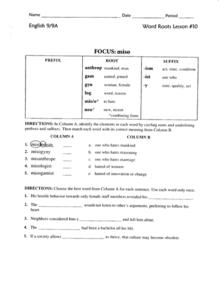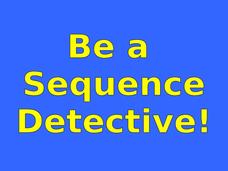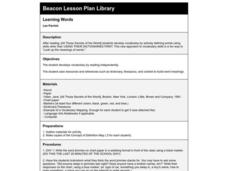Curated OER
Studying Idioms and Word Meaning
Idioms are really confusing, but learning them will help your readers deepen their understanding of a variety of texts. This 11-slide presentation offers several examples (like "break a leg" and "mind your manners") to help readers use...
Curated OER
Word Pair Analogies 6 (high-advanced level)
Linking words together in an analogy really deepens one's understanding of the word at hand. Use the example provided to guide your advanced English speakers (both native and non-native) in this analogy practice. More than likely, your...
Curated OER
Hamlet Word Search
If you're looking for a quick time filler, pass out this worksheet. High schoolers find the names of the characters introduced in Hamlet in a word search. An answer page is not provided, but it appears to be challenging as the print is...
Curated OER
Odyssey List 2 Vocab Worksheet
One of two epic poems attributed to Homer, The Odyssey is full of unfamiliar language. With this two-page activity, your class will study new words like victuals, forlorn, and pine. Unfortunately, the specific section these words come...
Curated OER
Word Roots Lesson #1 - Focus: chrom
What does the root word chrom mean? Review the root and the different prefixes and suffixes that can be added to it to enhance its meaning. Then, get your class using the new words with two short exercises. A brief introduction to the...
Curated OER
Word Roots Lesson #10 - Focus: miso
What does miso mean? Teach your class all about this root word with this quick practice sheet. After studying the chart provided, pupils learn new words that use the root and complete two short activities.
Hawaiʻi State Department of Education
Clay Creatures
When little ones make things out of clay they're not just exercising their creativity, they are following directions, developing fine motor skills, and building a sense of pride in their work. First graders use the pinch-and-score...
Roanoke County Public Schools
Be a Sequence Detective!
Authors are constantly leaving clues that help the reader to understand the sequence of events in a story. Teach young readers how to pick up on these key temporal words and phrases with this slide show. After an introduction to commonly...
Curated OER
Lesson Plan for Scaffolding Complex Texts
Enhance a class read-aloud of the children's story Hi! Fly Guy with this reading comprehension lesson. Children first listen as the teacher reads the story, stopping along the way to discuss any unfamiliar vocabulary. The book is then...
Curated OER
Pride and Prejudice: List-Group-Label
What words would you use to describe Mr. Darcy? What about Elizabeth? Use vivid vocabulary to create lists of adjectives to describe the characters of Jane Austen's Pride and Prejudice. After kids come up with their own lists of words,...
Curated OER
Language Arts Vocabulary Database
Students read a selection and identify the vocabulary words for the current week. Individually, they use the words to write in complete sentences and put the words into a database. They also practice their typing skills and must keep...
Curated OER
Language Arts: Vocabulary Words
In this language arts instructional activity, students unscramble the letters of 15 vocabulary words and spell them correctly. The instructional activity contains the solution.
Curated OER
Literacy: Slowly, Slowly, Slowly Said the Sloth
Learners explore language arts by analyzing a children's book in class. In this vocabulary lesson, students read the book Slowly, Slowly, Slowly... by Eric Carle. Learners identify the characters, setting and plot of the story before...
Curated OER
Getting to Know You
Students explore ways in which they are smart. In this "getting to know you" classroom team building lesson plan, students discuss various ways people can be smart and describe ways in which they are smart. Students listen to "Smart"...
Curated OER
The Art of Description
Students apply descriptive language to identify the five elements of art and the basic lines, geometric shapes, and angles in Marie Hull's, Sharecropper. They explain how the elements of a piece of work contribute to the story it tells....
Curated OER
Learning Words
Young scholars listen to Jane Yolen's, All Those Secrets of the World. They engage in activities to find word meanings without using a dictionary. They practice using a vocabulary mapping handout.
Curated OER
Vocabulary Building Cards
Students select vocabulary words from their reading each week then complete a card for each word which includes definition, source and a sample sentence. They share their cards with the class and complete vocabulary building cards...
Curated OER
ABC DETECTIVES
Students alphabetize words according to the first letter while pretending to be detectives with magnifying glasses. They also work on their social skills and character development when working with their teams and partners.
Curated OER
Words In the News- Canada Elects New Government
Learners participate in vocabulary building activities to read an online article about Canada. They complete worksheets and an online quiz. They work in groups to to develop policies for holding a class election.
Curated OER
Fill Me In
Second graders work on expanding their vocabulary. In this personal writing lesson, 2nd graders practice word identification and complete a worksheet by filling in the blanks.
Curated OER
Socials Word Search Puzzle
In this language arts activity, students study 32 words in a word bank, then locate them in a word search puzzle. There is no apparent connection between the words and the meaning of the title is not known. Note: Several words in the...
Curated OER
Using Fabrics in Your Art Curriculum
Students use a dicut machine to do block printing on fabric. In this fabric lesson plan, students draw, carve, and print onto blocks for this art project.
Curated OER
The Civil War in Art and Literature
Students examine art related to the Civil War. They participate in activities that allow them to write poetry and drawings. They create their own journal and collect their work in a binder.
Curated OER
What Number?
This simple activity provides a quick review of reading comprehension and vocabulary development skills. By answering the 10 multiple choice questions, learners identify the key elements of the story, and the meaning of vocabulary words.

























